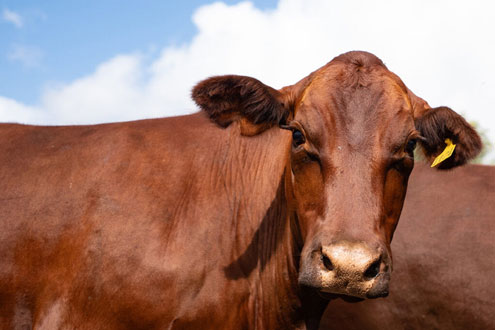Sun, heat and moisture can harm animals’ skin, but early care helps to keep livestock healthy
Most livestock species have thicker skin than humans, but it’s still vulnerable to harsh summer conditions. Sun exposure, bacterial infections and increased activity of parasite-carrying insects can all take a toll on livestock skin.
Each year, the Texas A&M Veterinary Medical Diagnostic Laboratory, TVMDL, receives samples that reveal how sweltering summers affect livestock health. It’s essential to act promptly to prevent skin irritation from becoming painful and causing serious harm.
Effective diagnostic testing, paired with veterinary care, can help guide treatment and protect both animals and producers’ livelihoods.
Erin Edwards, DVM, MS, DACVP, veterinary pathologist at TVMDL, explains three common summer skin conditions to watch for in warm weather.
Photosensitization: Severe sunburn caused by toxic plants
Just like humans, animals can experience a fiery reaction to summer rays.
“Effects of photosensitization are like a really severe sunburn,” Edwards said. “Livestock owners might see signs of redness, swelling and ulceration. Usually, the skin will start sloughing off, and it’s very uncomfortable for the animals.”

Primary photosensitization occurs when livestock become overly sensitive to sunlight after eating toxic plants containing the photosensitizing agent, phylloerythrin. The harmful compounds are concentrated in the skin, making it more susceptible to the sun’s rays.
“Burns are usually found on areas with less hair or pigmentation, like the nose or around the eyes,” Edwards said. “Lighter colored animals in general are usually more susceptible to burns.”
Secondary or hepatogenous photosensitization is the most common form of skin disorder. The prefix “hepato” comes from the Greek word “hepar,” meaning “liver.”
This form of photosensitization is caused by liver damage. Liver damage may result from a range of conditions, one of which is the consumption of toxic plants. When the liver fails to break down and eliminate substances like phylloerythrin, they begin to build up in the blood, increasing photosensitivity and causing the skin to react severely to sunlight.
In severe cases of photosensitization, skin, ear, lip and udder tissues may die and peel away. And secondary bacterial infections often occur after skin sloughing, leading to additional health concerns and delayed healing.
Furthermore, if livestock continue to consume toxic plants, liver damage could worsen and lead to death.
What to do if livestock show signs of sunburn or peeling:
- Move affected animals to shade immediately.
- Contact a veterinarian for diagnosis and care.
- Remove liver-damaging and phototoxic plants such as Bishop’s weed and Largeleaf lantana from pastures.
To learn how to identify harmful plants, read Toxic Plants of Texas, written by veterinary and toxicology experts from The Texas A&M University System.
Rain rot: Crusty skin infections after wet weather
Rain rot, a disease caused by the bacterium Dermatophilus congolensis, is a skin infection that typically develops when pasture animals spend long hours in rainy conditions. Prolonged moisture softens the skin, allowing bacteria to enter — even without visible wounds.
Rain rot may appear to be a minor skin irritation at first, but it can quickly worsen without proper care.
Rain rot signs include:
- Crusty, matted hair and patchy hair loss, typically starting on animals’ backs or around their feet.
- Sores along the back or lower legs.
- Raw, pink or bleeding skin in severe cases.
A lack of veterinary attention could lead to secondary infections that extend into the bloodstream or organs. Consult your veterinarian to speed up healing, ease discomfort and even prevent death.
Summer sores: Fly-transmitted wounds that won’t heal
Summer sores, or cutaneous habronemiasis, are open wounds that won’t heal. They’re caused by parasitic worms transmitted by flies — especially as fly activity increases during the summer. An immature habronema worm enters the body through the bite of a fly, specifically, by a housefly or stable fly.
Horses, donkeys and mules are most at risk, but other livestock can be affected.
Signs of summer sores include:
- Red, round wounds that won’t heal.
- Sores near eyes, lips or existing wounds.
- Inflammation and intense itching, caused by the worm burrowing inside the skin.
“The flies are attracted to areas where there’s moisture,” Edwards said. “They bite around the eyes, lips and especially where there are wounds or damaged skin.”
To protect livestock, owners should consider fly control in barns and pastures. They should also consult their veterinarian as soon as signs are spotted because summer sores don’t heal on their own. Without proper treatment, sores may become larger and more painful, usually leading to reduced mobility and a decline in overall health.
Healthy herds with expert support
Protecting livestock skin during the summer is essential to keeping animals healthy and productive. By staying alert to early signs of skin problems and working closely with veterinarians and diagnostic labs like TVMDL, livestock owners can prevent minor irritations from turning into serious, costly issues. With proper care and management, animals can stay comfortable and healthy during the summer.
Working alongside veterinarians, TVMDL experts can assist livestock owners with a range of diagnostic testing. For information about the laboratory’s veterinary diagnostic services, visit the TVMDL website or call the College Station laboratory at 888-646-5623 or the Canyon laboratory at 888-646-5624.


